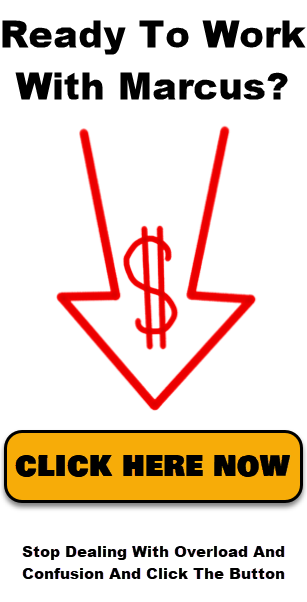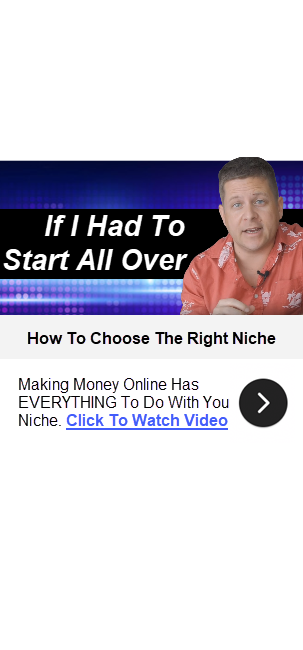The Truth About Blogging

Today we’re going to talk about what it actually takes to quit your job and start blogging full-time.
I want to ask you a question. If you could set up a simple blog in about an hour, and profit up to $32.17 or more every day from that blog, how many blogs would you set up?
I’ve made millions of dollars in affiliate commissions for simple sites I’ve made about things like the lottery, smiley faces, cheap gas prices, and mortgage calculators. Compare this with what the other guys are talking about. Compare this with the sites that they have, and a lot of them are in a lot more “buyer” niches or “make money” niches.
The cool thing here is the fact that I made tons of money with little bitty niches that no one thought I could make money in. Right now, as an entrepreneur, as someone who wants to make money blogging, you can say which market you want to go into.
How I Got Into Blogging
The way that I got into blogging was only after I learned direct response and I learned how to convert traffic.
In 2006, I made one of my most profitable sites. It made over 6 figures, and one year it made around $650,000. You might be thinking of that and saying that you can’t really do that on a blog. But you can. It’s your job to take your visitors where you want them to go.
This site made money because it was focused. Because it was based on human nature. You have to remember that no matter what, the people coming to your sites and your blogs are people. They respond. They click. This is based on human nature, and getting people to do what they want. And this works in any niche.
So it was 2006, and I had just made this site, making millions of dollars on the internet. I was on track that year for my first million-dollar-year with affiliate marketing.
I like to stay on top of all the new stuff. When Facebook came out, I thought, “How do we use this for marketing?” When YouTube came out, I thought, “How do we use this for marketing?”
Guys, remember that I’ve been doing this for almost 20 years now. And in that year, 2006, everyone was talking about blogs. They were like, “Blog this, blog that,” and I started to get tired of the hype. But then I thought, “Okay, let’s look into this.”

And I asked myself this question:
Can someone actually, really, seriously make a living blogging?
If you think about what a blog is, a lot of us have a certain idea about it. You think of this person who blogs about their eggs, and puts pictures on Instagram of their soup. And you think, “I don’t care about your eggs and your soup. I don’t want to do that.” Right? And that’s not really what blogging is.
So I asked myself, can someone make money doing this?
And more importantly, do you have to write every day, like those lame people on Twitter and Facebook who tweet or post every time they leave their house?
I was used to setting up simple little websites and banking $5, $10, $15, $100, or even $1,000 a day off of each website. The last thing I wanted to do was set up some huge content site. And I just couldn’t set up a blog like my simple websites. Those took like 45 minutes to an hour to build, and they raked it in big—sometimes they even made money the same day.
So there I was, listening to countless videos, teleseminars, webinars, reading al the e-books, and buying all the courses. I had serious info overload and burnout, and I was done. I threw in the towel. I thought to myself, “I’m done. This sucks. I’m not going to do it.” I was feeling so tired of trying to get my head around this blog thing. It made me sick. So I gave up right then and there. I said, “I don’t need a blog.”
I was on track to single-handedly make a million bucks, with no blogs, no employees, no outsourcing. Just some little sites that look like a fifth grader made (which mine still do, if anyone’s paying attention). And I was raking it in.
Then 2007 came. Again, I was sitting in my office and thinking, “I don’t need a blog. I’ve got it handled.” We did like $750,000 that year.
And then 2008 came around. Hmmm. Some of my sites started getting quality scored, slapped, and all that other stuff. I was making a decent income. We were in the mid-six figures. I thought, “Perhaps I’ll revisit this blog thing and see if Google likes them a bit better. I like free traffic.” (And free traffic is good if you know how to use it.)
Then it was 2009. I started freaking out. I had just bought a big, giant house. I was used to making $1 million a year, and now my sites were down to $250,000 profit. I thought, “That’s not bad.” I mean a lot of people would probably be happy with a quarter of a million dollars. But it wasn’t what I was used to. It wasn’t what I was planning on.

So in the summer of 2009, I thought more about blogs, and I decided I was going to do them on my own terms. No posting daily, no lame stuff. I didn’t really want to be the next Perez Hilton. I just wanted to earn a decent income from home. Was that too much to ask?
Later that year, I discovered the WordPress blogging platform. And I was able to set up my first blog in about 15 minutes. (And you can do that, too.) It wasn’t facy, it wasn’t beautiful, but I made it, and I was proud.
Now, little did I know, the next day the darn thing ranked on the top of Google in like 12 hours. I was like, “What? Wait a minute. I didn’t have to submit it? I didn’t have to wait it, and I didn’t have to wait three months, or six months?” I put the blog up, and I ranked number one.
I had no meta tags, no SEO stuff, I didn’t submit the site, didn’t do directory listing or backlinks. And I was like, “What the heck is going on here?” I didn’t even plan on it. I just wanted to set up a blog, and boom. The thing was in Google. It was getting traffic.
Here’s the thing: Google actually likes these blogs.
So I got some new paid traffic accounts, and tested the blogs there, and it worked. Some of them got leads and made money almost instantly, which was crazy. Now, instead of the one website stuff, with sites like the smiley face website which took a long time to set up (I had to do codes, put pages on, have to save stuff and upload it), I could actually bang out a little blog in like 12 minutes and get it ranked on the search engine like the next day. Which is crazy!
I could go find a keyword and get ranked. (Which is the key. Don’t go after a market, go after a keyword. If you go after the right keyword, you could get ranked so quickly. Because if there are only 9 people competing for a keyword, what are the chances you’re going to be in the top 10?
That’s exactly what it is. If there are only 9 people, and your site is number 10, you are guaranteed a top 10 ranking. Just because no one else is trying to rank for it.
So there I was, getting these things going. But there was one little hiccup, and it was actually a big hiccup.
Building websites the way I used to gave me the freedom to have whatever I want, wherever I wanted it. The key to making these little affiliate marketing sites work was all in the conversion. But the challenge now was getting my blog to do what my sites did, because that’s why they made money.
Here is what we needed. This is my website conversion checklist. But now, we have to use it on blogs. We’re going to ask ourselves these questions.
Blog Conversion Checklist and Guide

- Who am I trying to each?
Are you trying to reach people on Google searching for “how to lose 10 pounds”? Or looking for people on Google searching for “hospital scam”? Are you trying to reach people looking for “layouts”? What are you looking for?
- What do I want them to do?
Obviously, you want to make money. So you have to get an audience somehow. Do you want people to join your mailing list? Click an affiliate ad? Watch a video? What do you want them to do?
- What does my ad or site headline promise?
You have to look at what your site ad or your headline promises. When you go to Google and you search your site, what does it say? The little ranking that shows up in Google, what does it promise people? “Download this free thing”, “Learn how to do affiliate marketing”, “figure out the meaning of life”, etc. What does it say?
That is your site ad. No matter how you slice it, even if it’s free, that’s still your ad. It’s your free ad, right? And when people come to your site, they’re going to be looking for that. And if you don’t give it to them, they won’t be happy.
And here’s an interesting thing. You can actually flip people into what you want them to go into. For example, if you’re in that motorhome market, you could offer motorhome loans, or get people to click on things that are expensive, or find a guide for people to buy motorhomes, or something like that.
And make it deliberate. Make it up front.
How to Make Your Blog Convert in 3 Seconds or Less
- Does your site or blog cater to the type of user you’re trying to reach?
Make sure your blog isn’t too technical. If you’re marketing to 84-year-old grandmas, make it pretty basic. Make things big, easy to read, with big fonts, and simple “click here” buttons. If you’re marketing to people searching for cell phone gadgets, make it hip, cool, and fun. Think, focus, test.
Is it any wonder that my stuff looks like it was made in the 70s?
What influenced my stuff was making it easy. How many of you guys look at my toolbar, and you think, “I can find what I want”? You’re there and you go for it. How many of you guys go to my website and think, “That’s so easy to use”? If you want to log in, you click on “log in”. If you want help and support, you click on the “help and support”. If you want the desktop tools, they’re right there
If you want to search for something, you search for something. It’s very basic and very easy. The reason I do this isn’t because I’m a terrible website designer. I do it because it has to be easy. It has to be simple. It has to be something that says, “This is what you want, and here is where to get it.”
- Can my visitor find the promise in less than 3 seconds?
Let’s say you put up a blog post about pricing. And you tell your visitors “This blog post is about how I saved $1,000 a month in my budget.” If that’s what you’re promising your visitors, and they come to your site, can they find that in 3 seconds? If they can’t, go hang out with the club of people only making 2 cents a click.
So, give them that. Make a big button. Or a drop-down box. Make something they can use. Remember, your visitor came to your site because of the promise found in your advertisement, your banner, or your search engine listing. They’re on your site because they want the goods. If they can’t see the promise in 3 seconds, they’re gone. So give them what they want.
You guys are here because you want to learn to make a living blogging. Imagine if I came here and said, “Today we’re going to talk about PHP and the backend of WordPress, and I’m going to show you how to make a little money here.” You would say, “Dude, this isn’t what I wanted. I came here because I want to make a living blogging.”
That’s why friends of mine who hang out on my webinars ask me, “How do you get most of the people to stay until the very end?” And it’s because I give the people what I promised.
Realize that you don’t have to deliver the whole promise up front in one sentence. You can simply have a headline with the promise in it, or an opt-in box saying, “Download your promise here by entering your name and email.” Very simple.
- Is your site focused on what you want the user to do most?
What do you want them to do? If you want them to get a mortgage, maybe you should have a zip code box that says, “put your zip code to find mortgages.” It’s focused on what you want. If you want them to download those little cursors and smileys or whatever they may be, do you have them on there? Are they easy to get?
If you want your visitors to opt in, make that the main point of your site. Don’t distract your visitors with AdSense links or videos. Keep it one-sided. If you have content, the content should lead them to opt in. If you have a video, the video should say to opt in. Whatever the big promise is, if there are images, put a caption below the image, or blur a part of it out, and say, “put your name and email to get the whole image.”
- Do my colors and themes compliment or distract from my message?
This is one thing a lot of people get wrong.
Now, I was gifted with the ability to make really simple sites—because I don’t know how to make complicated ones. It was actually a blessing in disguise, because simple is what sells. A simple color change can be the difference between profit and money loss.
If you’re marketing to Halloween people, they probably don’t want a pink, flowery site. If you’re going for a wedding, they probably don’t want a black site (unless they’re going for gothic weddings, then maybe they’d want that).
Here’s a tip: Make your headlines red. If there are links you want clicked, make them blue. Make buttons easy to read and click. Make directions clear and concise.
So many people don’t follow this. Use short sentences, simple to read, simple stuff. Tell people what you want. Do you want people to buy stuff? Tell them. Do you want people to click? Tell them. Do you want people to download stuff? Tell them. Do you want people to opt in? Say, “Put your name and email in the box at the end of this webinar.”
This is something I do on each one of my own webinars. When I get to the sales page, I show you how to fill out my order form. Is that because I think you don’t know how to fill out an order form? No, of course not. It’s because I want to show you what to do.
I’m going to say, “After you order, you’re going to get this. It’s going to come in your email.” And you’ll think to yourself, “Wow, after I order, I’m going to get all this stuff. Why do I do that? Because it’s simple. It tells you what to do.
You have to tell your visitor what to do. They don’t always know. Marketers often assume that they’re visitors do know what to do. They assume, “Oh, visitors will click the affiliate offer because it’s great”, or “They’re going to join my product because it’s great”. But people don’t know your product is great until you tell them it’s great. And you have to tell them it’s great based on the reason they came to you in the first place.
To learn more, go to www.AffiliateMarketingDude.com.

